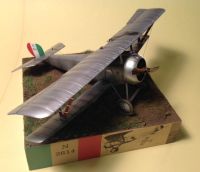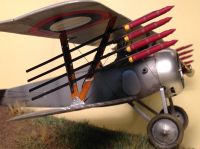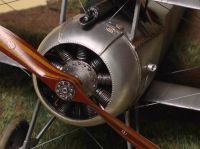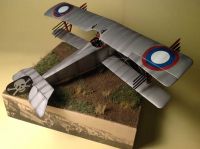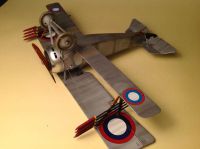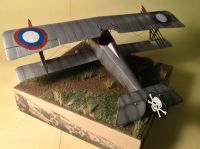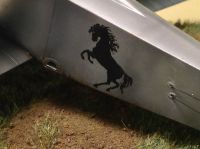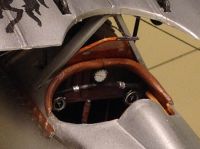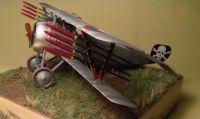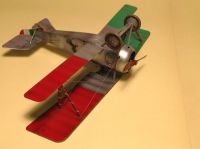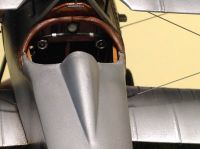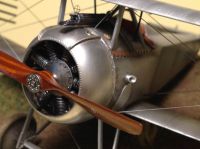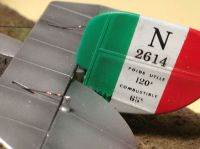Academy 1/32 "Export" Nieuport 17s
By Russell Bucy
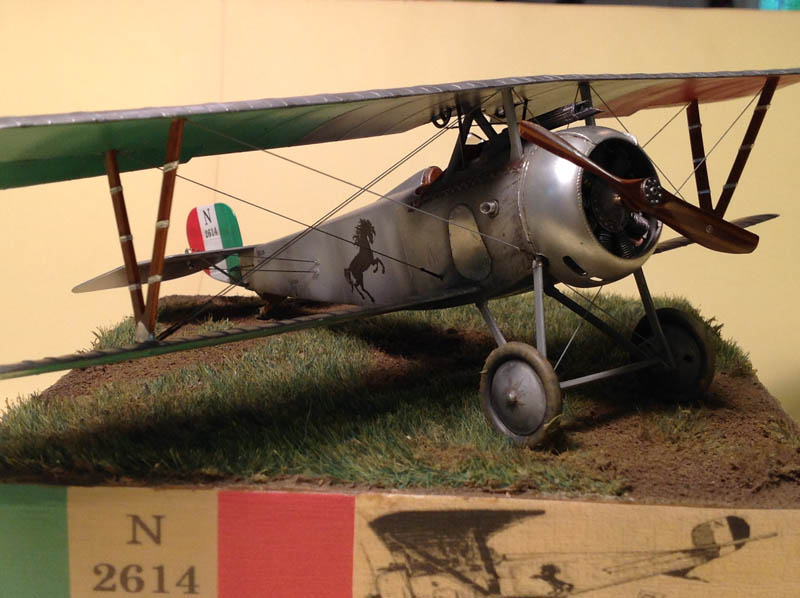
Continuing with my "double builds" of WWI aircraft, I've chosen two Academy Nieuport 17s to build as aircraft flown by Italy and Russia. The Nieuport 17 was diminutive in size, making it ideal as an export aircraft. The 1/32 Academy/HobbyCraft/Italeri Nieuport 17 is likewise simple, cheap and readily available.
History
The Nieuport 17 sesquiplane was small, nimble and cheap. As such, it was favored by pilots and widely exported to many allied nations. Italy and Russia were two of the biggest importers. Probably the most famous Italian Ace was Major Francesco Barraca. His Nieuport 17 was marked with the "Cavallino Rampante" or rearing stallion. He chose the black stallion because he was an accomplished equestrian and cavalry officer. After Barraca was killed in action, his mother gave permission to Enzo Ferrari to use the "Cavallino Rampante" symbol on Ferrari's race cars, establishing an automotive legacy for Ferrari and a lasting tribute to Barraca even 100 years after his death. Barraca flew several Nieuports, a SPAD VII and XIII, but his favorite seemed to be Nieuport 17 number N2614 with the "Cavallino Rampante" painted on both sides of the fuselage. Several artists have depicted a large "Cavallino Rampante" on the upper wing as well, but there is no photographic evidence of this. Nieuport N2614 was one of the earliest Nieuports exported to Italy, and may have had French insignia on the upper wings which were painted over by applying additional aluminum dope, while the underside outboard wings were painted in green and red with a central silver fuselage and wing roots to emulate the national colors of Italy. Macchi also built 150 Nieuport 17s under license, but many were imported. The Imperial Russian Air Service imported 50 Nieuport 17s directly from France, and hundreds more were built under license by DUX, the Russian national aircraft manufacturer, but they were often inferior in quality, so many Russian pilots preferred the original French imports. The 19th KAO (squadron) of the 1st BAG (Air Group) of the Imperial Russian Air Service flew many Nieuport 11s and 17s, marked with either a black skull and crossbones on a white background for the staff flight, or a white skull and crossbones on a black background for the line flight. My daughter loves pirate movies and horses, so it was natural to build these Nieuports in those markings!
The Kit
The Academy/HobbyCraft boxings have been around over 20 years. The Italeri boxing is a recent release of this kit, with nice decals for Barraca's aircraft, but I used Academy's Guynemer/Nungesser versions as I had several of these kits. The kit cockpit detail is rudimentary and the cockpit opening is incorrect. The wings are nicely done and are prototypically thin, with thin trailing edges and raised ribs to depict the rib tapes. The engine is simple, but adequate. The kit is fairly accurate in shape, and by 1/32 standards, rather small, but the real aircraft was also small. The struts and tail surfaces are thin and in scale. The cowling is rather basic, and needs some added detail.
Modifications
- The cockpit coaming was enlarged toward the rear, and a "backstop" and head rest were constructed from sheet styrene. Interior framing was constructed from wood, strip styrene, and soldered brass tube. I used Tom's Model Work's Nieuport photo-etch sets for the seat, seat frame, throttle and rudder pedals. Instruments were made from styrene rod and brass bezels with Mike Grandt decal faces. Lap belts are from an Eduard pre-painted French WWI belt set. Both kits had sheet styrene ammunition boxes constructed to fit just in front of the instruments, which effectively fill the forward fuselage - without this detail, the entire front of the fuselage up to the firewall would be a large void.
- The Vickers gun for the real Nieuport 17 had the charging handle come up and over the windscreen. I fashioned this from thin brass wire. The gun was fed by a fabric ammo belt from a tray under the right side of the forward fuselage decking. The fabric belt passed through the gun, and went down a chute through the left side of the fuselage decking to a take up reel in the left side of the ammo box. The kit supplies the take up chute on the left, but not the ammo feed chute on the right side. This was constructed out of styrene stock. The gun had the upper recoil spring and the cowling blast shield built from brass rod wrapped in fine wire for a spring, and thin sheet brass for the blast shield. The Russian Nieuport had a brass gunsight added from the spares box.
- I built an oil tank and filler port just behind the engine from sheet styrene. Fuel and oil filler caps were fashioned on the left side of the upper fuselage and cowling from styrene discs and strips. The Engine received styrene rod and fine copper wire for plugs and wiring. The engine was mounted on a brass rod and tube shaft which also serves as prop shaft.
- The Nieuport cowling was a two piece affair, with an inner ring riveted to the circumference of the cowling opening for strength, and a removable section at the top. The removable section was bolted to the cowling using two flanges which were prominent at the top of the cowling. To service the engine, the top section was unbolted and removed so the cowling could be swung down to clear the propeller. The kit has the inner ring just inside the cowling opening, but no rivets around the circumference or flanges at the top of the cowl. I added the flanges with strip styrene and the rivets around the circumference were done with Archer Fine Transfers.
- The props were airbrushed Tamiya deck tan with NATO brown for the laminations. Burnt Umber oil paint was wiped with foam rubber across the width of the prop, not the length - this gives a nice "cross section" look to the laminations. I sped the drying of the oil paint by airbrushing a light coat of Testors Dullcoat. I then airbrushed the props with a thinned coat of Tamiya clear orange and masked and painted the prop hubs in Model Master gun metal.
- The Tom's Model Work's Nieuport set provided the stitching along the fuselage sides, which was covered with strips of self adhesive aluminum muffler tape from the Wal-Mart automotive section and painted brown to represent the leather covers on the real aircraft. The kit supplies decals for this, but the stitching really stands out on the real Nieuport.
- The step on the left side of the fuselage below the cockpit was drilled and carved out. For Barraca's aircraft, I cut strips of aluminum muffler tape and applied them over the existing wing ribbing on the kit wings as rib tapes. For both models, I used this tape cut very thin for the bindings on the struts and for the wing strut sockets on the lower wing.
- Aileron control pushrods and counterbalances that came through the forward fuselage decking to the upper wing were offset to correspond to the aileron position.
- Nieuports were seldom painted in anything but aluminum dope to delay the effects of deterioration from sunlight. I used Floquil Old Silver on the wings and fuselages with Alclad "light sheen" clearcoat to simulate the aluminum dope finish. A liberal post shading was done with Model Master Burnt Umber in a 25/75 mix of paint/thinner sprayed at 8-10 PSI. In some cases a "post it note" was used to mask different fabric panels. The cowling received a base coat of Alclad "Black Primer and Micro-porefiller", followed by a coat of Alclad Chrome which looks like polished metal.
- Both aircraft were rigged with brown "Chameleon" 4lb fishing line carefully brush painted with Testor's "French Gray" after installation. The turnbuckles are by Eduard. Control wires were left in the brown color, with a dab of Elmers glue applied with a needle leaves a nice "bead" of glue, which was painted brass to simulate control wire turnbuckles.
- Markings for Barraca's Cavallino Rampante and all the stencils and numbers were created in Photoshop and PowerPoint, and printed on my HP ink jet printer. I spray clear decal sheets with Testor's Dullcoat, this gives the printer ink something to bind to. I sometimes run the sheet through the printer a second or third time to get the depth of color I want. After drying I spray Micro-Scale Decal Film over the decal to bind it to the paper. The only exception was the French Nieuport data markings for weight (poids utile) and fuel (combustibles) on the tail that came in the kit. Strangely, it appears Barraca's Nieuport 17 only had this information on the left side of the tail, while the "N2614" number was on both sides. The decals for the Russian national insignia and the 19th Squadron death head on the tail are from Spada. I found the Spada decals tough to work with because they stick immediately and are hard to get into position, but they do look superb. Barraca's Nieuport came directly from France, so it was likely marked with French insignia on the upper wing. I airbrushed the French insignia and over coated them with silver paint. When dry I used fine steel wool to polish the paint so the insignia just shows through the top layer of paint. To finish everything off, Testor's Acrylic "Dirty Oil" wash was liberally brushed over the engine, lower fuselage surfaces, and behind the cowlings for that "castor oil stained" look.
- The inspection port/valve stem opening in the wheel cover appears to be on the inside of the wheels in photos. I drilled a hole completely through the wheels, and reversed them on the models, with the inspection port to the inside. An axle cap was made using two different sizes of punched sheet styrene disks. The plastic tail skids were replaced with strip brass for strength, and some static grass and "dirt" was added for the "used" look.
- The Russian Nieuport was equipped with Le Prieur rockets for balloon busting. This system consisted of a cardboard tube rocket body and a warhead equipped with two knifelike cutting edges. I constructed the launch system from brass strip and Albion Metals brass tubing soldered together using a jig. The rocket bodies are styrene tube, with brass rails. The "razor cutting tips" are triangular pieces of thin K&S brass sheet, placed in a slot in the rocket warhead. Since the bottom rocket had a tendency to scorch the lower wing fabric, I simulated the coating of heat resistant paint with a strip of decal paper painted Alclad Polished Aluminum.
- I found period photos and drawings appropriate for Russian and Italian Nieuports on line and printed them out in strips which were then decoupaged to the bases. The bases were covered with random patches of Noch brand static grass and sand mixed with diluted Elmer's Glue and acrylic brown craft paint to simulate a grass/dirt field.
Conclusions
These were fun and fairly quick builds. The Academy/HobbyCraft/Italeri kit is the only 1/32 Nieuport 17 kit but it's not a bad kit. With a little imagination it can be made into a very nice model. Beginning WWI aircraft modelers won't have any trouble with it as the rigging is minimal, the fit is good, and painting is simple. The only real drawback is the rather simple cockpit, but with some work this can be easily fixed. It's also a great model for super detailing if desired.
References
- The Francesco Barraca Museum in Lugo (Bologna) Italy. -- eng.museobarraca.it
- Aviation Factfile, Biplanes, Triplanes & Seaplanes. Jim Winchester, Grange Books
- Color Profiles of WWI Combat Planes. Giorgio Apostolo & Giorgio Begnozzi, Crescent Books
- Nieuport Fighters in Action. Peter Cooksley, Squadron Publications
- Nieuport Aces of the Great War. Norman Franks, Delprado/Osprey Publishing
- Aircraft in Profile, Nieuport 17. C. F. Andrews, Doubleday Publishing
- Aircraft of WWI 1914 - 1918. Jack Herris & Bob Pearson, Amber Books
- Classic WWI Aircraft Profiles, Vol. 2. Edward Shacklady & Terry Treadwell, Cerberus Publishing
© Russell Bucy 2017
This article was published on Tuesday, July 11 2017; Last modified on Tuesday, July 11 2017

